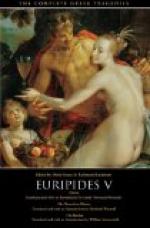The same signs, described in one case by the same peculiar word, occur here. The Old Man mentions one after the other, and Electra refutes or rejects them. It has been thought therefore that this scene was meant as an attack—a very weak and undignified attack—on Euripides’ great master. No parallel for such an artistically ruinous proceeding is quoted from any Greek tragedy. And, apart from the improbability a priori, I do not think it even possible to read the scene in this sense. To my mind, Electra here rejects the signs not from reason, but from a sort of nervous terror. She dares not believe that Orestes has come; because, if it prove otherwise, the disappointment will be so terrible. As to both signs, the lock of hair and the footprints, her arguments may be good; but observe that she is afraid to make the comparison at all. And as to the footprint, she says there cannot be one, when the Old Man has just seen it! And, anyhow, she will not go to see it! Similarly as to the robe, she does her best to deny that she ever wove it, though she and the Old Man both remember it perfectly. She is fighting tremulously, with all her flagging strength, against the thing she longs for. The whole point of the scene requires that one ray of hope after another should be shown to Electra, and that she should passionately, blindly, reject them all. That is what Euripides wanted the signs for.
But why, it may be asked, did he adopt Aeschylus’ signs, and even his peculiar word? Because, whether invented by Aeschylus or not, these signs were a canonical part of the story by the time Euripides wrote. Every one who knew the story of Orestes’ return at all, knew of the hair and the footprint. Aristophanes in the Clouds (534 ff.) uses them proverbially, when he speaks of his comedy “recognising its brother’s tress.” It would have been frivolous to invent new ones. As a matter of fact, it seems probable that the signs are older than Aeschylus; neither they nor the word [Greek: homopteros] particularly suit Aeschylus’ purpose. (Cf. Dr. Verrall’s introduction to the Libation-Bearers.) They probably come from the old lyric poet, Stesichorus.
P. 43, l. 652, New-mothered of a Man-Child.]—Her true Man-Child, the Avenger whom they had sought to rob her of! This pitiless plan was suggested apparently by the sacrifice to the Nymphs (p. 40). “Weep my babe’s low station” is of course ironical. The babe would set a seal on Electra’s degradation to the peasant class, and so end the blood-feud, as far as she was concerned. Clytemnestra, longing for peace, must rejoice in Electra’s degradation. Yet she has motherly feelings too, and in fact hardly knows what to think or do till she can consult Aegisthus (p. 71). Electra, it would seem, actually calculates upon these feelings, while despising them.
P. 45, l. 669, If but some man will guide me.]—A suggestion of the irresolution or melancholia that beset Orestes afterwards, alternating with furious action. (Cf. Aeschylus’ Libation-Bearers, Euripides’ Andromache and Orestes.)




